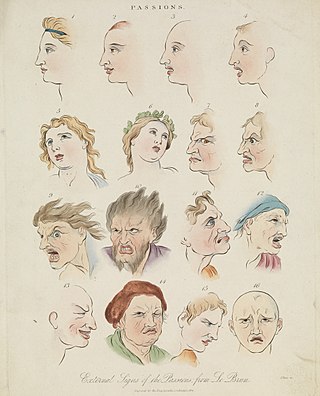Related Research Articles

Guilt is a moral emotion that occurs when a person believes or realizes—accurately or not—that they have compromised their own standards of conduct or have violated universal moral standards and bear significant responsibility for that violation. Guilt is closely related to the concept of remorse, regret, as well as shame.

Shame is an unpleasant self-conscious emotion often associated with negative self-evaluation; motivation to quit; and feelings of pain, exposure, distrust, powerlessness, and worthlessness.
In the field of psychology, cognitive dissonance is the perception of contradictory information and the mental toll of it. Relevant items of information include a person's actions, feelings, ideas, beliefs, values, and things in the environment. Cognitive dissonance is typically experienced as psychological stress when persons participate in an action that goes against one or more of those things. According to this theory, when an action or idea is psychologically inconsistent with the other, people do all in their power to change either so that they become consistent. The discomfort is triggered by the person's belief clashing with new information perceived, wherein the individual tries to find a way to resolve the contradiction to reduce their discomfort.

Job satisfaction, employee satisfaction or work satisfaction is a measure of workers' contentment with their job, whether they like the job or individual aspects or facets of jobs, such as nature of work or supervision. Job satisfaction can be measured in cognitive (evaluative), affective, and behavioral components. Researchers have also noted that job satisfaction measures vary in the extent to which they measure feelings about the job. or cognitions about the job.

An attitude "is a summary evaluation of an object of thought. An attitude object can be anything a person discriminates or holds in mind." Attitudes include beliefs (cognition), emotional responses (affect) and behavioral tendencies. In the classical definition an attitude is persistent, while in more contemporary conceptualizations, attitudes may vary depending upon situations, context, or moods.

Self-handicapping is a cognitive strategy by which people avoid effort in the hopes of keeping potential failure from hurting self-esteem. It was first theorized by Edward E. Jones and Steven Berglas, according to whom self-handicaps are obstacles created, or claimed, by the individual in anticipation of failing performance.
Affect theory is a theory that seeks to organize affects, sometimes used interchangeably with emotions or subjectively experienced feelings, into discrete categories and to typify their physiological, social, interpersonal, and internalized manifestations. The conversation about affect theory has been taken up in psychology, psychoanalysis, neuroscience, medicine, interpersonal communication, literary theory, critical theory, media studies, and gender studies, among other fields. Hence, affect theory is defined in different ways, depending on the discipline.
Ambivalence is a state of having simultaneous conflicting reactions, beliefs, or feelings towards some object. Stated another way, ambivalence is the experience of having an attitude towards someone or something that contains both positively and negatively valenced components. The term also refers to situations where "mixed feelings" of a more general sort are experienced, or where a person experiences uncertainty or indecisiveness.

Affect, in psychology, refers to the underlying experience of feeling, emotion, attachment, or mood. In psychology, "affect" refers to the experience of feeling or emotion. It encompasses a wide range of emotional states and can be positive or negative. Affect is a fundamental aspect of human experience and plays a central role in many psychological theories and studies. It can be understood as a combination of three components: emotion, mood, and affectivity. In psychology, the term "affect" is often used interchangeably with several related terms and concepts, though each term may have slightly different nuances. These terms encompass: emotion, feeling, mood, emotional state, sentiment, affective state, emotional response, affective reactivity, disposition. Researchers and psychologists may employ specific terms based on their focus and the context of their work.

Regret is the emotion of wishing one had made a different decision in the past, because the consequences of the decision one did make were unfavorable.

Edward Tory Higgins is the Stanley Schachter Professor of Psychology and Business, and Director of the Motivation Science Center at Columbia University. Higgins' research areas include motivation and cognition, judgment and decision-making, and social cognition. Most of his works focus on priming, self-discrepancy theory, and regulatory focus theory. He is also the author of Beyond Pleasure and Pain: How Motivation Works, and Focus: Use Different Ways of Seeing the World for Success and Influence.
Psychoanalytic criminology is a method of studying crime and criminal behaviour that draws from Freudian psychoanalysis. This school of thought examines personality and the psyche for motive in crime. Other areas of interest are the fear of crime and the act of punishment.

Emotion classification, the means by which one may distinguish or contrast one emotion from another, is a contested issue in emotion research and in affective science. Researchers have approached the classification of emotions from one of two fundamental viewpoints:
- that emotions are discrete and fundamentally different constructs
- that emotions can be characterized on a dimensional basis in groupings

Negative affectivity (NA), or negative affect, is a personality variable that involves the experience of negative emotions and poor self-concept. Negative affectivity subsumes a variety of negative emotions, including anger, contempt, disgust, guilt, fear, and nervousness. Low negative affectivity is characterized by frequent states of calmness and serenity, along with states of confidence, activeness, and great enthusiasm.
Affect measures are used in the study of human affect, and refer to measures obtained from self-report studies asking participants to quantify their current feelings or average feelings over a longer period of time. Even though some affect measures contain variations that allow assessment of basic predispositions to experience a certain emotion, tests for such stable traits are usually considered to be personality tests.
Experiential avoidance (EA) has been broadly defined as attempts to avoid thoughts, feelings, memories, physical sensations, and other internal experiences — even when doing so creates harm in the long run. The process of EA is thought to be maintained through negative reinforcement — that is, short-term relief of discomfort is achieved through avoidance, thereby increasing the likelihood that the avoidance behavior will persist. Importantly, the current conceptualization of EA suggests that it is not negative thoughts, emotions, and sensations that are problematic, but how one responds to them that can cause difficulties. In particular, a habitual and persistent unwillingness to experience uncomfortable thoughts and feelings is thought to be linked to a wide range of problems.
Objective self-awareness is attention focused on the self as a socially evaluable object, as defined by Shelley Duval, Robert Wicklund, and other contemporary social psychologists.
Measures of guilt and shame are used by mental health professionals to determine an individual's propensity towards the self-conscious feelings of guilt or shame.
Guilt-free consumption (GFC) is a pattern of consumption based on the minimization of the sense of guilt which consumers incur when purchasing products or commercial services.
Self-blame is a cognitive process in which an individual attributes the occurrence of a stressful event to oneself. The direction of blame often has implications for individuals’ emotions and behaviors during and following stressful situations. Self-blame is a common reaction to stressful events and has certain effects on how individuals adapt. Types of self-blame are hypothesized to contribute to depression, and self-blame is a component of self-directed emotions like guilt and self-disgust. Because of self-blame's commonality in response to stress and its role in emotion, self-blame should be examined using psychology's perspectives on stress and coping. This article will attempt to give an overview of the contemporary study on self-blame in psychology.
References
- ↑ Higgins, E. Tory; Roney, Christopher J. R.; Crowe, Ellen; Hymes, Charles (1994). "Ideal versus ought predilections for approach and avoidance distinct self-regulatory systems". Journal of Personality and Social Psychology. 66 (2): 276–286. doi:10.1037/0022-3514.66.2.276. ISSN 1939-1315. PMID 8195986.
- ↑ Festinger, L. (1957) A theory of cognitive dissonance, Stanford, CA: Stanford University Press [ verification needed ]
- 1 2 3 Erikson, E. H. (1968). Identity: Youth and crisis. New York:Norton.
- 1 2 3 4 5 6 7 8 9 10 11 12 13 14 15 16 17 18 19 20 21 22 23 Higgins, E. T. (1987). Self-discrepancy; A theory relating self and affect, Psychological Review, 94, 319–340.
- 1 2 3 Higgins, E.T., Roney, C.J.R., Crowe, E., Hymes C. (1994). Ideal versus ought predilections for approach and avoidance: Distinct self-regulatory systems, Journal of Personality and Social Psychology, 66, 276-286.
- ↑ Wells, L. E. & Marwell, G. (1976) Self-esteem: Its conceptualization and measurement. Beverly Hills, CA: Sage.
- ↑ Carver, C.S., Lawrence, J.W., & Scheier, M.F. (1999). Self-Discrepancies and Affect: Introducing the Role of Feared Selves. Personality and Social Psychology Bulletin, 25, 7, 783-792.
- 1 2 Higgins, E. T. (1999). Who do self-discrepancies have specific relations to emotions? The second-generation question of Tangney, Niedenthal, Covert, and Barlow (1998). Journal of Personality and Social Psychology, 77(6), 1313-1317.
- ↑ Tsaousides, T., & Jome, L. (2008) Perceived career compromise, affect and work-related satisfaction in college students. Journal of Vocational Behavior, 73(2), 185–194.
- ↑ Scott, L., & O'Hara, M.W. (1993). Self-discrepancies in clinically anxious and depressed university students. Journal of Abnormal Psychology, 102, 282–287.
- ↑ Heidrich, S. M., & Powwattana, A. (2004). Self-Discrepancy and Mental Health in Older Women with Chronic Illnesses. Journal of Adult Development, 11(4), 251-259(9).
- ↑ Matthews, A., & Lynn, S. (2008). Subclinical bulimia vs. depression in an interpersonal context. Eating Behaviors, 9(4), 509-512.
- ↑ Beattie, S., Hardy, L., & Woodman, T. (2004). Pre-competition self-confidence: The role of the self. Journal of Sport & Exercise Psychology. 26(3), 427–441.
- ↑ Tangney, J.P., Niedenthal, P.M., Vowell, Covert M. and Hill, Barlow D., (1998). Are shame and guilt related to distinct self-discrepancies? A test of Higgin's (1987) hypotheses. Journal of Personality and Social Psychology, 75, 256–268.
- ↑ Orellana-Damacela, L.E., Tindale, T.S., & Suarez-Balcazar, Y. (2000). Decisional and behavioral procrastination: How they relate to self-discrepancies. Journal of Social Behavior and Personality, 15, 225–238.
- ↑ Tangney, June Price; Niedenthal, Paula M.; Covert, Michelle Vowell; Barlow, Deborah Hill (1998). "Are shame and guilt related to distinct self-discrepancies? A test of Higgins's (1987) hypotheses". Journal of Personality and Social Psychology. 75 (1): 256–268. doi:10.1037/0022-3514.75.1.256. ISSN 1939-1315. PMID 9686463.
- ↑ Ozgul, Salih; Heubeck, Bernd; Ward, Jeff; Wilkinson, Ross (2003). "Self-discrepancies: Measurement and Relation to Various Negative Affective States". Australian Journal of Psychology. 55 (1): 56–62. doi:10.1080/00049530412331312884. ISSN 1742-9536.
- ↑ Watson, Neill; Bryan, Brandon C.; Thrash, Todd M. (January 2016). "Self-discrepancy: Long-term test–retest reliability and test–criterion predictive validity". Psychological Assessment. 28 (1): 59–69. doi:10.1037/pas0000162. ISSN 1939-134X. PMID 26029943. S2CID 40661494.